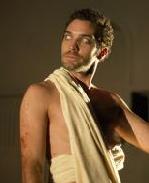SITE GUIDE
REVIEWS
FEATURES
NEWS
Etcetera and
Short Term Listings
LISTINGS
Broadway
Off-Broadway
NYC Restaurants
BOOKS and CDs
OTHER PLACES
Berkshires
London
California
DC
Philadelphia
Elsewhere
QUOTES
On TKTS
PLAYWRIGHTS' ALBUMS
LETTERS TO EDITOR
FILM
LINKS
MISCELLANEOUS
Free Updates
Masthead
Writing for Us
A CurtainUp  London Review
London Review
 London Review
London ReviewFaustus
|
This is Hell – enjoy the party!
---- Foster |

Jake Maskall as Mephistopheles
(Photo: Manuel Harlan) |
The brilliant Rupert Goold, director and co-adapter, dramatises a recent event and develops it as a parallel narrative: that of artist provocateurs, the Chapman brothers and their controversial decision to "rectify" Goya's etchings by painting over scenes of suffering with clown faces. Into the legendary Faustus' history, scenes of this modern story are interwoven. However, the Chapman brothers are not represented as a simple analogy of selling one's soul but rather as a shifting paradigm. The shared focus between the old and the new dramas is the irrevocable and momentous deed committed by the protagonists.
Stephen Noonan and Jonjo O'Neill are superb as the nihilistic, deconstructive or perhaps just destructive artists. In scruffy paint-splattered jeans and sneakers, they have a compelling stage presence and are very intense in their conviction that they can turn men from sheep into ‘suffering gods' through the power of art. Nevertheless, upstaging everyone, is Mark Lockyer's fabulously funny Foster, a BBC art critic and poseur extraordinaire. His character is hilariously pretentious and an absolute pleasure to watch.
Conversely, the Marlowe scenes are played straight, largely unadapted and in period dress. By maintaining this in the midst of startling innovation, we have the double advantage of the beautiful 16th century poetry enlivened by 21st century relevance. Scott Handy, who plays Faustus, does well at delivering the language, although at times he struggles to engage as much as the modern characters.
It is said that early performances of the play were so terrifying that audiences believed the devil had actually appeared onstage. Jake Maskall's Mephistopheles, although perhaps not quite this petrifying, is not far off. His movement is incredibly creepy and his pupils are blanked out by white contact lenses. Wearing a dirty, askew toga, he slithers across the stage in an unmistakably inhuman and animalistic manner. He hisses at Faustus' first demand of servitude.
The two strands of the play begin as a series of distinct scenes, separated by revolving sets and slow-motion switches. However, as the play proceeds, they begin to merge and overlap. For example, the Chapman brothers hear Faustus' devil-summoning spells on their answer-phone. And at the Royal Academy opening of their installation, Hell, Faustus and Mephistopheles descend and mingle. Pointing out the attendees as the embodiments of the seven deadly sins, Mephistopheles (still slithering) helps himself to a glass of champagne.
Rupert Goold may have handled Marlowe in the same way that the Chapman brothers treated Goya: with newfangled, audacious interpolation. However, such artistic vandalism is utterly justified in this case. Marlowe's play is revivified whilst the new story is grounded with a shape which autobiographical material always struggles to find. This bold, assured production is exemplary in terms of writing, cast, direction and design as well as being both moving and intellectually stimulating.
|
FAUSTUS
Written by Christopher Marlowe adapted by Rupert Goold with Ben Power Directed by Rupert Goold With: Scott Handy, Stephen Noonan, Jonjo O'Neill, Mark Lockyer, Jason Morell, Jake Maskall, Sophie Hunter, Daniel Curshen, George Franco, Anneka Haskins, Susanna Hislop, Andrew Mathys, Gemma Measom , Isabelle Agerbak, Elinor Agerbak, Caitlin Burrows, Freya Burrows Design: Laura Hopkins Lighting: Malcolm Rippeth Composer and Sound Design: Adam Cork Running time: Two hours 30 minutes with one interval Box Office: 020 722 9301 Booking to 18th November 2006 Reviewed by Charlotte Loveridge on 24th October 2006 performance at the Hampstead Theatre, Eton Avenue, Swiss Cottage, NW3 (Tube: Swiss Cottage) |




